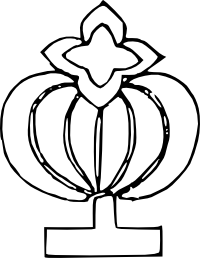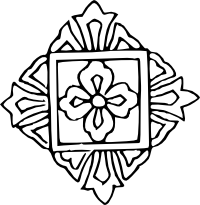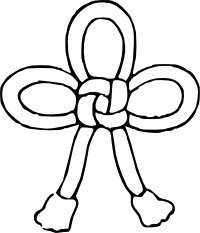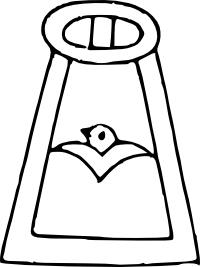Recreational research into Feudal Japan
Mon
Primary Source: Kenmon Shokamon
Jun 5th (a Shakkō (赤口))
O-umajirushi is great for an idea of what mon were like in the Momoyama period, but what were they like before that? There are few earlier sources for mon other than depictions of battle scenes and similar. One that I have found, however, is Kenmon Shokamon (見聞諸家紋), which translates to “Various Observed Family Crests”. It’ss an excellent collection of a wide variety of earlier mon, some of which have been featured on this blog as “provincial samurai” mon. It was originally published around 1467–1470, and it features crests that were observed on the banners and camp curtains of the Ōnin War, which started the Sengoku period.(ja.wp:見聞諸家紋) It contains a variety of combinations and motifs that are rare or absent by the time of the later codifications. I recently got access to the full text of this source via Google Books and shenanigans, and it has plenty of interesting designs, featuring a wide selection of plovers and also including a phoenix, a horse, and a shrimp. It also features some unexpectedly pictorial designs that in some ways are more similar to the later Edo period designs than those in common use around the Momoyama period. Its selection of mon that combine multiple elements in different ways will be useful for those seeking to register mon in the SCA.
I haven’t had time for detailed analysis as of yet, but I present the text for your enjoyment:
Link: O-umajirushi
Jul 19th (a Daian (大安))
Preparing for teaching a class at Pennsic (my first!) on Japanese heraldry, I’ve been gathering some good sources for figures. One of the best primary sources for Sengoku-era heraldry is O-umajirushi, a collection of heraldic displays printed somewhere in 1624–1644. Contrary to some sources, all six scrolls still exist, and I just discovered they can be found online at the National Diet Library of Japan. Enjoy!
Link: A Roll of Japanese Armory
Jun 12th (a Sembu (先負))
Just found an article that’s apparently been up for a while on the Academy of Saint Gabriel where the illustrious Solveig Throndardottir discusses family crests: A Roll of Japanese Armory. It’s short, but it features several pages of mon from the Battle of Sekigahara in 1600, which is handy for those seeking a wider selection of Azuchi-Momoyama period (1573 to 1603) mon.
Link: Samurai Heraldry: Flags and Standards of Samurai Armies
Dec 27th (a Tomobiki (友引))
It’s still a while before the lunar New Year, but I hope those of you with modern holidays are enjoying them. Perhaps one of these winters I’ll actually girl up to building a Sei Shonagon-style snow mountain. I just wanted to follow up my recent link post on samurai banners: some more banner depictions by the same artist and more background information can be found in a forum thread: Samurai Heraldry: Flags and Standards of Samurai Armies. May the your modern New Year be auspicious to you all.
Two Mysterious Mon
Dec 13th (a Shakkō (赤口))
Finishing off the provincial samurai mon, I have two flower designs that I haven’t been able to find elsewhere and haven’t figured a convincing explanation for viagra pharmacie en ligne.(KJ:7) Flower variations are probably the most common type of mon, so it’d make sense that there were variations that didn’t catch on, but the specific flowers these are supposed to be remains a mystery to me. The first perhaps is on a melon, and the second has an intricate angled square design. Maybe one of you will have some insight?
Mon of the Week: Bowl with Chopsticks
Dec 5th (a Sembu (先負))
The basic bowl-with-chopsticks design, simply a circle above two horizontal lines, was first used as a seal in ancient times. It is associated with a tale about the founder of the Narita family: faced with a battle after running out of provisions, he visited a shrine, ate the offering of rice left there, and proceeded to fight most impressively.(Dower:106) This variation, from the collection of provincial samurai mon,(KJ:7) has filled in the bowl with a simple perpendicular-lines pattern of a type used on fabric..
Mon of the Week: Knot
Nov 28th (a Tomobiki (友引))
Continuing with the provincial samurai mon, we have this simple depiction of a knot.(KJ:7)
This is not just any knot, however. This knot is called “agemaki” (総角) and auspiciously symbolizes the four directions. It is hung above sumo rings, and was used on samurai armor both for decoration and as a structural component.(Samurai Weapons) For these reasons and its graphical simplicity, it makes a lot of sense as a samurai mon. Slightly more stylized depictions continue to be used in mon today,(Kamon Composition Maker) albeit rarely.
Less relevantly, it names a similar-looking historical (but later) hairstyle and type of dance in kabuki. Nowadays, they are used to decorate cars in Japan’s “VIP style”.(Diamond Zeus)
Mon of the Week: Enclosed Goose
Oct 25th (a Tomobiki (友引))
At the other end of the spectrum in terms of realism from the Perching Hawk is this mon below, from the same collection of provincial samurai mon.(KJ:7) The highly stylized bird in the middle is a wild goose, and this depiction of geese is still common through the present day. Geese are associated with good news and gracefulness.(NHK Online) More mysterious is the enclosure around the goose. It bears some similarity to a piece of horse equipment (aori/泥障) that would hang from the saddle and sit between the rider’s legs and the horse’s body; these could be decorated with mon the way the plover image appears here. This explanation isn’t entirely convincing, so there could be other possibilities.
Note: This entry originally inaccurately identified the bird as a plover instead of a wild goose. Plovers were a common motif in Japanese poetry, with connotations of longevity based on their cry “chiyo” (thousands of generations).(Komuso)
In addition, one source identifies this enclosure as tongs.
Mon of the Week: Perching Hawk
Oct 4th (a Butsumetsu (仏滅))
Last week we looked at feathers, and today we look at the bird they come from. While animals are relatively rare in mon relative to Western heraldry, they are not unknown, and various birds are the most common. This is a hawk from the same collection of provincial samurai mon.
As mentioned last week, falconry was popular among the samurai class, and this hawk, tethered to a perch, is a such a captive bird. It is an unusually realistic depiction for an early mon, with high levels of detail and some three-dimensional aspects to the drawing. This depiction of the hawk did not catch on, and more stylized and flat designs, without an accompanying perch, remained the general rule until modern times.(KJ:7)






